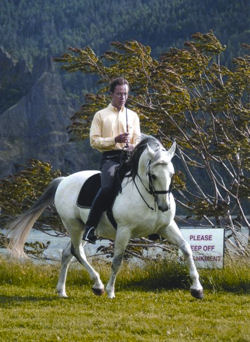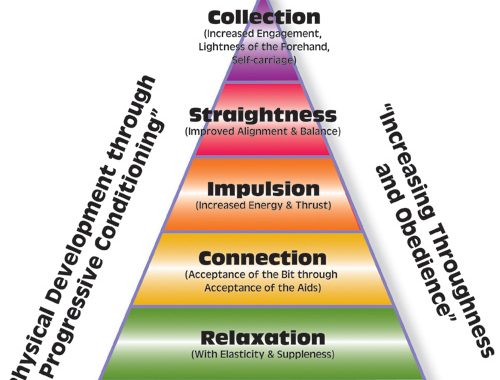Elasticity – The Mastery of Give and Take

Elasticity, by definition, is a measure of responsiveness. The response is a result of an outside force acting upon a variable. In dressage, elasticity pertains to the responsiveness of the horse to his rider’s aids. Elasticity is the overall adjustability of the horse within his gaits and the movements. It does not mean faster and slower, but rather maintaining cadence while covering more or less ground. At no time should the horse lose his overall rhythm. The elasticity spectrum is exemplified in the extended canter, canter pirouettes and piaffe presented in the FEI levels. As the horse develops in his training, elasticity will continue to improve. Each level requires the horse to demonstrate greater levels of elasticity through varied movements and paces exhibited.
Training Elasticity in the Dressage Horse
The training of elasticity begins at the very early stages of dressage. Suppleness, which includes elasticity and relaxation, are only preceded by Rhythm. In Training Level, the natural way of going, or rhythm, is evaluated. This natural movement is apparent in the horse’s working gaits and demonstrates energy and tempo. Starting at First level, the horse begins developing elasticity through the lengthening of the trot and canter. As a rider, effective use of the arena can help to establish appropriate lengthening and collecting of the horse. The long sides and diagonals are perfect for lengthening, while the corners are best for collecting. Because First Level horses lack the necessary muscle strength and stamina to perform collection and lengthening for extended periods, the rider must be cognizant of the horse’s ability. If the horse begins to fall on the forehand, the rider should bring the horse back to a more collected frame, thus putting more weight on the hind legs. The young horse will require numerous transitions to help him establish his strength and stamina.
By Second level, the horse is introduced to collected and medium paces. As the horse develops in his training, elasticity should be equal on both sides of the pendulum. The horse’s ability to  lengthen should be equal to his ability to collect. A good test of the horse’s ability to collect is the canter-walk-canter transition. Other exercises to assist in developing collection are the shoulder-in, travers and renvers, but only if a solid foundation of basics has been established.
lengthen should be equal to his ability to collect. A good test of the horse’s ability to collect is the canter-walk-canter transition. Other exercises to assist in developing collection are the shoulder-in, travers and renvers, but only if a solid foundation of basics has been established.
Third level adds the extended paces. These paces are the most ground covering and require the hind end to carry weight continually. In extension, the horse must show definite over-tracking of the hind legs. The third levelhorse should also demonstrate more power and more consistent cadence when collected than in previous levels. This level really begins to test the overall strength and stamina of the horse. It is also a test of the rider’s attention to detail and the training scale. Holes in previous training become extremely apparent as the horse progresses to this level.
Fourth level is the final test before moving on to the FEI. At this level, the horse is expected to perform pirouettes. The horse should demonstrate a distinct lowering of the croup while maintaining his cadence and elasticity. The collected trot, at this level, is the pre-cursor to the piaffe found in later tests. From this point on, the horse and rider are expected to work on the refinement and fluidity of their transitions.
The FEI levels continue to test the horse’s elasticity through more drastic transitions like canter to halt. The horse should not lose his balance and rhythm during these transitions. It should be mentioned at this point, that with the shortening and lengthening of stride also comes the shortening and lengthening of the top line. This is a necessity for the proper execution of collection and extension. The poll should always remain at the highest point and the horse should maintain consistent contact with the bit. In extension, however, the horse should reach slightly in front of the vertical to enable him to cover enough ground to reach where his toe is pointing. It is imperative that the rider continue to allow the horse to develop his elasticity at this level. This is done by returning to the basics and focusing on developing the horse’s responsiveness to the slightest of aids. If the horse is trained properly, execution of progressive movements will be easier.
Elasticity and the Dressage Horse
Elasticity is essential for the horse to be successful as a dressage mount. Training of this responsiveness revolves around the horse listening to his rider’s aids and the rider listening to his horse’s needs. By listening, the rider is better able to focus his warm-up and training  segments around his horse’s ability to perform the required tasks. This often changes from day-to-day and week-to-week. Focusing on the horse will enable the rider to know when and how far to push and when and how much to come back . The rider must also develop certain characteristics to effectively train elasticity. First is the development of an elastic seat. If the rider does not have a well-balanced, feeling seat, he will generally perch on his hands and bounce on the horse’s back thus creating tension in the horse’s mouth and back. Elasticity is strongly dependent upon a connection between the driving force of the hind quarter and the horse’s mouth. In addition, the horse must have both longitudinal – front to back – and lateral – side to side – flexibility. This is generally demonstrated by the horse’s willingness to stretch his frame and to move off the leg, respectively. Only when the horse and rider have effectively developed their strength, stamina and their ability to communicate seamlessly, can one demonstrate the full spectrum of elasticity.
segments around his horse’s ability to perform the required tasks. This often changes from day-to-day and week-to-week. Focusing on the horse will enable the rider to know when and how far to push and when and how much to come back . The rider must also develop certain characteristics to effectively train elasticity. First is the development of an elastic seat. If the rider does not have a well-balanced, feeling seat, he will generally perch on his hands and bounce on the horse’s back thus creating tension in the horse’s mouth and back. Elasticity is strongly dependent upon a connection between the driving force of the hind quarter and the horse’s mouth. In addition, the horse must have both longitudinal – front to back – and lateral – side to side – flexibility. This is generally demonstrated by the horse’s willingness to stretch his frame and to move off the leg, respectively. Only when the horse and rider have effectively developed their strength, stamina and their ability to communicate seamlessly, can one demonstrate the full spectrum of elasticity.
Author: Dressage Academy
You May Also Like

Rhythm – Let’s Get into the Groove Newsletter
March 28, 2018
Rejuvenate Your Dressage Horse
July 6, 2017